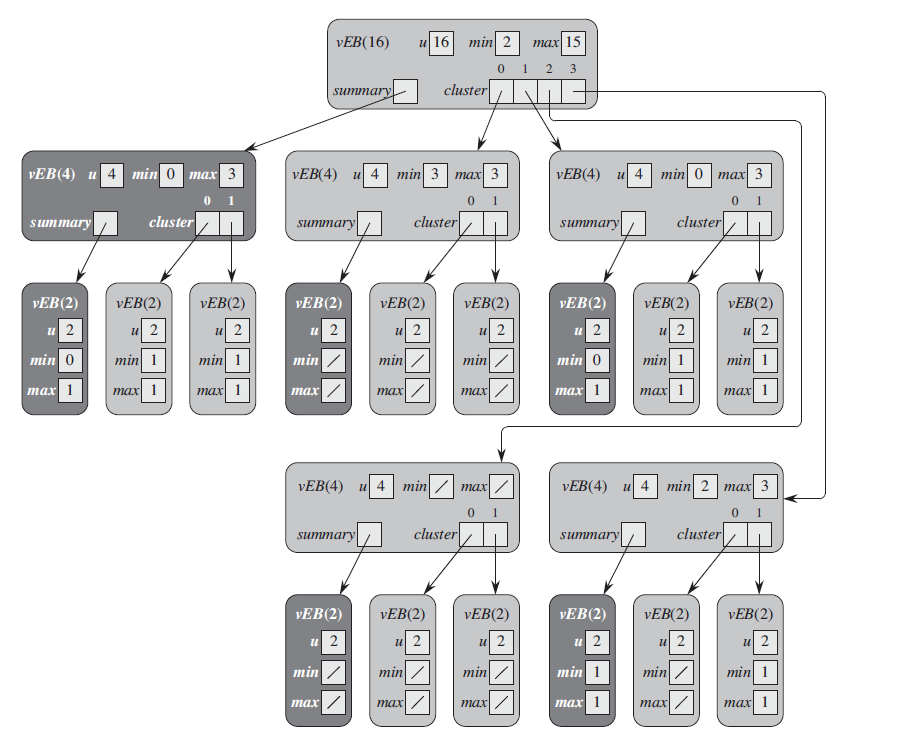- A min/max-heap is a data structure that obeys the min-heap property — the key of a node is greater than or equal to / less than or equal to the key of its parent.
Mergeable Heap
-
A mergeable heap is any data structure that supports the following operations
MAKE_HEAP- create and return a heap with no elementINSERTinserts an elementwhose key has already been filled in, into heap . MINIMUMreturns the pointer to the element inwhose key is minimum EXTRACT-MIN- delete the minimum element and return a pointer to it.UNION- return a new heap that contains all the elements of the input heaps. Both input heaps are destroyed.
-
Mergeable heap operations are lazy and defer work as late as possible.
Fibonacci Heap
-
A Fibonacci Heap also supports the following
DECREASE_KEYassigns to elementwithin heap the new key value which is no greater than the current key value. DELETEdeletes elementfrom heap .
-
More formally, a Fibonacci heap is a collection of rooted Tree where each tree obeys the min-heap property.
- All nodes in the tree are, ideally, linked together in a circular, doubly linked list.
- All nodes keep track of their degree and whether or not they are marked. A node is marked if it lost a child since the last time they were made the child of another node.
- The roots of all trees in a Fibonacci heap are linked together into a circular doubly linked list referred to as the root list
-
Fibonacci heaps have good amortized asymptotic time bounds.
MAKE_HEAP,INSERT,MINIMUM,UNION, andDECREASE_KEYtaketime. The other operations take . -
The asymptotic bounds are dependent on the maximum degree
. -
If we only use the regular mergeable heap operations, we have that
. If we include
DECREASE_KEYandDELETE, we have.
-
-
Fibonacci heaps are desirable when we rarely
DELETEorEXTRACT-MIN. In practice, however, the complexity they have make them less desirable than ordinary heaps. -
The
MINIMUMis found by maintaining a pointer to the root containing the minimum key. This pointer is updated during other operations -
The
MERGEoperation concatenates the root lists of two heaps together, and sets theMINIMUMas the smaller of the two heaps. -
The
INSERToperation involves a node being appended to the root list. -
DELETE_MINworks in three phases.-
The root containing the minimum element is removed and each of its
children becomes a new root. -
There may be up to
roots. Successively link roots of the same degree while maintaining the min-heap property (make the one with the larger key the child of the other). Repeat until all nodes have a different degree. Use an array of length
which maintains a list of pointers to one root of each degree. Link two roots if they have the same degree.
-
Update the
MINIMUMaccordingly.
-
-
DECREASE_KEYworks using cascading cuts.- First, if decreasing a key violates the min-heap property, cut it from the parent and update the minimum pointer if needed.
- Start from the parent of
. As long as the current node is marked, cut it from the parent and make an unmarked root. - Stop when we reach an unmarked node
. If is not a root, it is marked.
-
(CLRS 19.1) Let
be any node in a Fibonacci heap, and suppose . Let be the children of in the order they were linked. Then and for . 7. -
(CLRS 19.4) Let
be any node in a Fibonacci heap and . Then where is the -th Fibonacci number and is the golden ratio
van Emde Boas Tree
-
Supports the set operations of heaps in
time provided that the keys are integers in the range with no duplicates, where denotes the size of the universe. -
We make use of a summary array structure to store whether or not an array contains a particular key. The summary array contains a
of and only if the subarray contains a -
The key idea is to recursively use the summary array structure such that a new summary array encodes the one at the previous level of recursion. At the
-th level the size of the universe is - The
arises because we start with needing bits to encode the first summary array. Then at each level we reduce this number by half.
- The
-
More formally, the van Emde Boas tree or vEB tree for a universe of size
is denoted . - If
, then it is the base size and we can store an array of two bits. - Otherwise, in addition to the universe size
, the data structure contains - A summary array structure which is a
tree. It keeps track of which children are non-empty. - An array cluster of
pointers, each to a structure.
- A summary array structure which is a
- If

-
Data is stored as follows.
- The smallest and largest values are stored in
T.minandT.maxrespectively. - Any value
is stored in the subtree T.children[i], where.
- The smallest and largest values are stored in
-
van Emde Boas Trees do not have optimal memory. For an
bit integer, it requires bits of storage.
Links
- CLRS - Ch. 19, 20